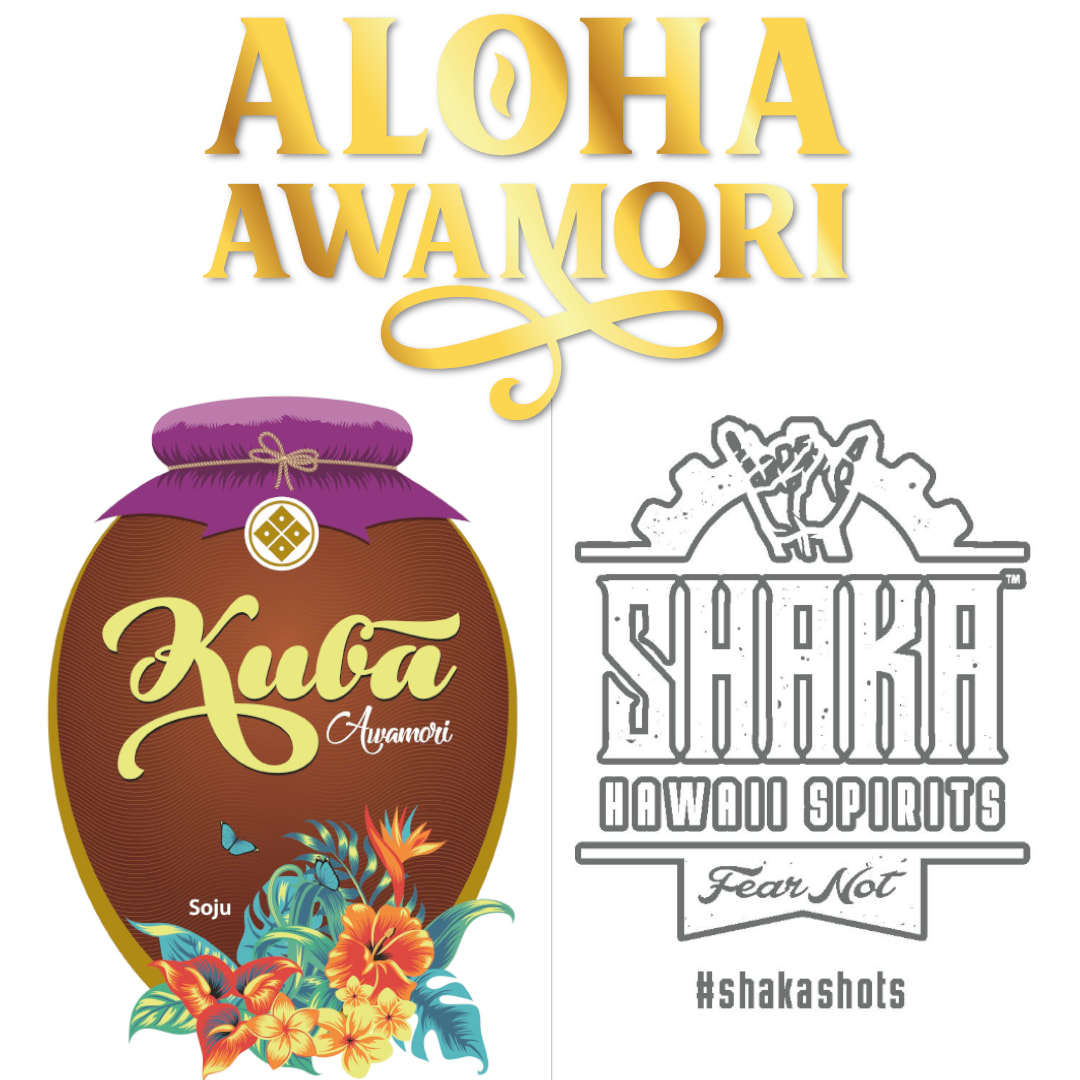Aloha Awamori blends traditional Okinawian distilling with techniques from Hawaii’s Okinawan Plantation days to create a unique set of products. According to founder Randy Kuba, “Okinawan is an island community and Hawaii is an island community, so we’re trying to collaborate together to try to do something economically for everyone here.”
-
Founding Story
-
Team
<
>
“My grandparents homeland is in Okinawa. They emigrated to the plantations then, went to farming. I was interested in learning more about my culture, heritage and tradition. When I went to Okinawa, I went into the villages to try to learn more. All the villages had what they call Awamori. I noticed that all of the villagers participated in making the Awamori in some way. The rice growers grew rice and the villagers worked in the Awamori distillery. A lot of the villagers, they depend on the Awamori as their lifeblood because they sell it outside and then the revenue comes back in, helps the village. Because I have relatives over there, this is a good way of helping both island communities.”
Randy Kuba, Founder and does a little bit of everything. Other partners include Steve Sue who designed the Shaka bottle and does branding and marketing and Tim Caminos who is on the business side.
Ingredients
-
Rice
-
Sugarcane
-
Koji
-
Water
<
>
Thai Indica rice is always used in Awamori by legal definition
According to Kuba, “from my observation, it's fresh-pressed, because the sugarcane is right there, the rice fields are on this side.”
“Distilleries use the same basic black koji that's indigenous in Okinawa. Basically, they have 46 distilleries in Okinawa, one in each village. They share the black koji because during the Battle of Okinawa in the late 1940s, the whole industry was ruined, but somehow they found that black koji and revived the industry.” Said Kuba.
All spirits are brought to proof in Okinawa.
Production Process
-
Koji Propagation
-
Ichiji Shikomi (First Shikomi)
-
Distillation
-
Resting in Kame
-
Transport of Distillate to Hawaii
-
Conditioning
<
>
Koji is made by sprinkling koji ken onto steamed rice.
43% ABV Awamori
Koji and water are added to a fermentation tank. Yeast is allowed to grow and form into the the moromi (mash).
24% Rice and Sugarcane Spirit
Both Koji and fresh sugarcane juice are added to the fermentation tank. Yeast is allowed to form into the the moromi (mash).
Koji and water are added to a fermentation tank. Yeast is allowed to grow and form into the the moromi (mash).
24% Rice and Sugarcane Spirit
Both Koji and fresh sugarcane juice are added to the fermentation tank. Yeast is allowed to form into the the moromi (mash).
Distillation occurs in the traditional method: One pass through a pot still.
The 43% (ABV) Awamori from Nakijin Shuzo Distillery is rested in Kame either for three years or ten years.
The 24% ABV Sugarcane and Rice Spirit from Taikoku is rested for one year in Kame.
The 24% ABV Sugarcane and Rice Spirit from Taikoku is rested for one year in Kame.
Both the 24% and the 43% are shipped to Hawaii in DSP approved and bonded 18-liter bags.
After removing the awamori from the transport bags, it undergoes a unique charcoal conditioning process. Not traditionally used in Okinawa, this stems from a Hawaii plantation technique. According to Kuba: “When I talked to the [Glen and Amy] Shinsato’s and the old plantation families, they used to make what they called swipe with pineapple. At that time Kiawe charcoal was used to filter and purify the swipe because Kiawe was the hardest wood in Hawaii.”
The Awamori
-
Kuba 3 Year Kiawe
-
Kuba 10 Year
-
Sugarcane and Ginger
-
Chili Pepper
-
Kona Coffee
-
Shaka
<
>
hree year old kusu of 43% ABV from Nakijin Distillery is then conditioned with Kiawe for 19 days. “We go about 19 days conditioning with the Kiawe wood. That's why you get this darker color, because it comes in clear.” After the 19 days, the Kiawe wood is removed and charcoal is added.
Average Retail Price 375ml: $70
Average Retail Price 375ml: $70
10 year old 43% ABV Awamori from Nakijin Distillery in Northern Okinawa
Rested in Kiawe charcoal in Hawaii for 19 days. This resting period was derived from trial and error.
Average Retail Price 375ml: $85
Rested in Kiawe charcoal in Hawaii for 19 days. This resting period was derived from trial and error.
Average Retail Price 375ml: $85
Sugarcane and ginger is infused into the 24% ABV Sugarcane and Rice Spirit from Taikoku Distillery. The ginger used in the recipe is Hawaii grown in the Kahalu area of Oahu. This recipe originated on the Hawaii Plantations. According to Kuba, “Glen and Amy Shinsato had the formula in their napkins from their grandfathers bar, and they took that, and made it work for the Awamori. Again, and it was a matter of trial and error.”
Average Retail Price for 375 ml: $15.99
Average Retail Price for 750 ml: 29.99
Average Retail Price for 375 ml: $15.99
Average Retail Price for 750 ml: 29.99
Chili Pepper is infused into the 24% ABV Sugarcane and Rice Spirit from Taikoku. The combination of awamori and chili pepper in Okinawa is called koregusu. According to Kuba, “In Okinawa, it's on the table everywhere because their liquor laws are not like here. They put it in soups, they put in soba, they put it in fish, they cook with it. The Okinawa community is a little different from the Japanese community. We have different types of food, different types of ways of doing things.”
To source the chili peppers, the company first starts with Hawaiian Chili Pepper. According to Kuba, “We started out with “We started out with using Hawaiian chili pepper, but we couldn't get enough. We get some from Hilo, because that's where the source is for short Hawaiian chili pepper. Currently we get a base of Hawaiian chili pepper then add different types of different chili pepper including jalapeno Right now, we're still in experimental stage, but it has been label-approved as Hawaiian chili pepper.”
Average Retail Price for 375 ml: $22.99
To source the chili peppers, the company first starts with Hawaiian Chili Pepper. According to Kuba, “We started out with “We started out with using Hawaiian chili pepper, but we couldn't get enough. We get some from Hilo, because that's where the source is for short Hawaiian chili pepper. Currently we get a base of Hawaiian chili pepper then add different types of different chili pepper including jalapeno Right now, we're still in experimental stage, but it has been label-approved as Hawaiian chili pepper.”
Average Retail Price for 375 ml: $22.99
24% ABV Sugarcane and Rice Spirit from Taikoku infused with 100% Kona Coffee. No additional sugar is added.
Average Retail Price for 375 ml: $17.99
Average Retail Price for 375 ml: $17.99
This 24% ABV Sugarcane and Rice Spirit from Taikoku was made for the millennial market. The formula is similar to Kuba Awamori, but aged a little longer in kame. According to Kuba, “The Kuba Awamori, original, is straight from the distillery over here. We age it about one year in Okinawa, and then it does have a little smoother taste. It's made to be smooth, made with no bite. In Okinawa, a lot of the younger generation they put the bottle in the freezer, and then they just drink it cold like that. It is made for the tourist market, because when we did go to some of the retailers, they said, it should be a Hawaiian name, if you want to sell it.”
The bottle label reads soju because of two factors: In California Korean community helped pass a law which allowed for spirits labeled soju with under 25% ABV to be sold in soft liquor establishments.
The bottle label reads soju because of two factors: In California Korean community helped pass a law which allowed for spirits labeled soju with under 25% ABV to be sold in soft liquor establishments.
Retail Availability
The product can be found in Neiman Marcus, Times, Tamura’s, Marukai, and Don Quijote, on the regular shelves, but Aloha Awamori and the Shaka are not currently available. Hawaii Liquor Laws do allow for made in Hawaii spirits to be sold direct from the manufacturer without going through a distributor. To purchase directly from Aloha Awamori, visit their website or schedule an appointment to visit their tasting room.


 RSS Feed
RSS Feed